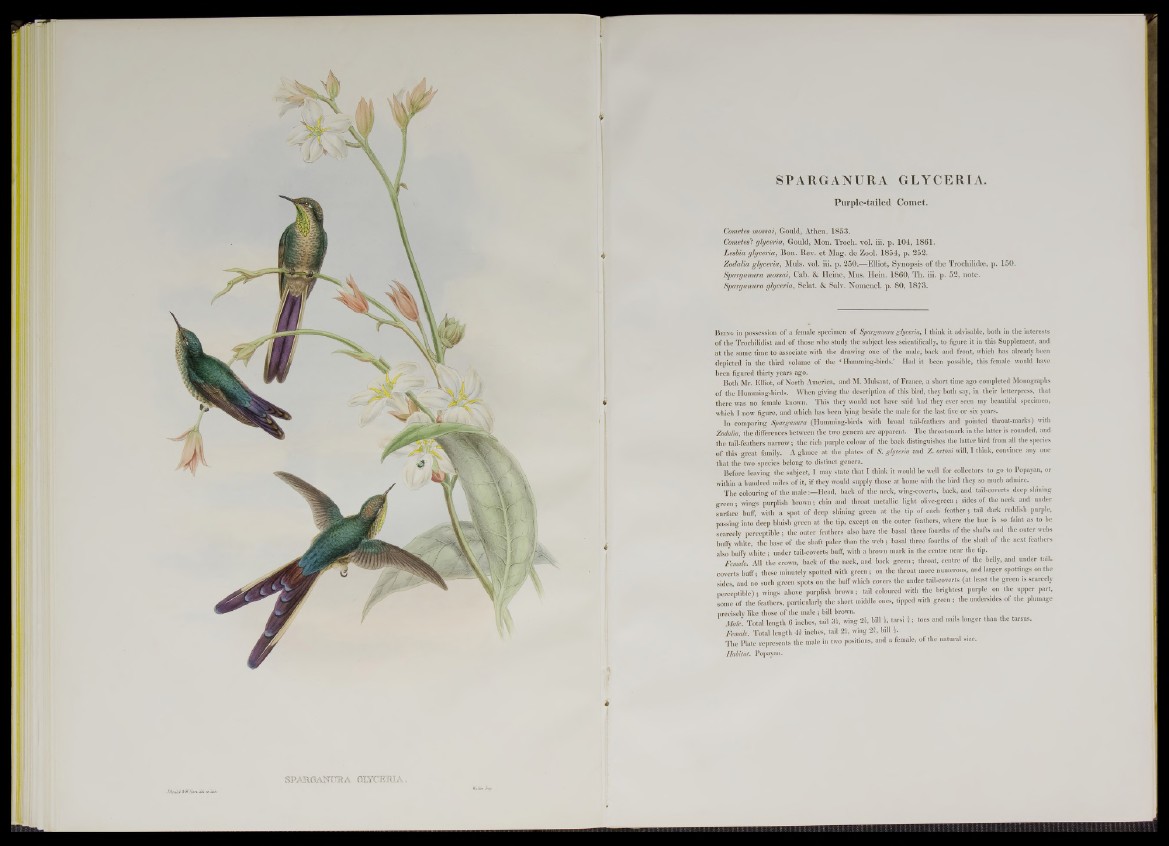
SPARGANURA GLYCERIA*
SPARGANURA GLYCERIA.
Purple-tailed Comet.
Cometes mossai, Gould, Athen. 1 8 5 3 .
Cometest glyceria, Gould, Mon. Trocli. vo l. iii. p. 1 0 4 , 1 8 6 1 .
Lesbia glyceria , Bon . Rev. e t Mag. de Zool. 1 8 5 4 , p. 2 52.
Z o dalia g lyc e ria , Muls. vol. iii. p. 2 5 0 .— Ellio t, Synopsis o f th e Trochilidse, p. 1 50.
Sparganura mossai, Cab. & H eine, Mus. H ein. 1 8 6 0 , Th. iii. p. 5 2 , note.
Sparganura glyceria, Sclat. & Salv. Nomencl. p. 8 0 , 1873.
B e in g in possession of a female specimen of Sparganura glyceria, I think it advisable, both in the interests
o f the Trochilidist and o f those who study the subject less scientifically, to figure it in this Supplement, and
at the same time to associate with the drawing one of the male, back and front, whicb has already been
depicted in the third volume of the ‘ Humming-birds.’ Had it been possible, this female would have
been figured thirty years ago.
Both Mr. Elliot, o f North America, and M. Mulsant, of France, a short time ago completed Monographs
of the Humming-birds. When giving the description of this bird, they both say, in their letterpress, that
there was no female known. This they would not have said had they ever seen my beautiful specimen,
which I now figure, and which has been lying beside the male for the last five or six years.
In comparing Sparganura (Humming-birds with broad tail-feathers and pointed throat-marks) with
Zodalia, the differences between the two genera are apparent. The throat-mark in the latter is rounded, and
the tail-feathers narrow; the rich purple colour of the back distinguishes the latter bird from all the species
o f this great family. A glance at the plates o f S. glyceria and Z. ortoni will, I think, convince any one
that the two species belong to distinct genera.
Before leaving the subject, I may state that I think it would be well for collectors to go to Popayan, or
within a hundred miles of it, if they would supply those at home with the bird they so much admire.
T h e co lo u rin g o f th e m a le :— H e ad , back o f th e neck, wing-coverts, back, an d tail-coverts deep shining
g r e e n ; wings purplish b row n ; chin an d th ro a t metallic lig h t o liv e -g re en ; sides o f th e neck an d u nder
su rface buff, w ith a sp o t o f d e e p sh in in g g re en a t th e tip o f each f e a th e r ; tail d a rk reddish purple,
p assing in to d e e p bluish g re e n a t th e tip , ex c ep t on th e o u te r fe ath ers, whe re th e hue is so famt a s to be
sca rce ly p e rc ep tib le ; th e o u te r fe a th e rs also have th e basal th re e fo u rth s o f th e shafts an d th e o u te r webs
buffy white, th e base o f th e sh aft p a le r th an th e web ; basal th re e fourths o f th e sh aft o f th e n ex t feathers
also buffy wh ite ; u n d e r tail-cove rts buff, w ith a brown mark in th e c e n tre n e a r the tip.
Female. All the crown, back o f the neck, and back green; throat, centre of the belly, and under tail-
coverts buff; these minutely spotted with green; on the throat more numerous, and larger spottmgs on the
sides, and no such green spots on the buff which covers the under tail-coverts (at least the green is scarcely
perceptible); wings above purplish brown; tail coloured with the brightest purple on the upper part,
some o f the feathers, particularly the short middle ones, tipped with green ; the undersides of the plumage
precisely like those o f the male; bill brown.
Male. Total length 6 inches, tail 34, wing 21, bill i , tarsi f ; toes and nails longer than the tarsns.
Female. Total length 41 inches, tail 21, wing 2f, bill 1.
The Plate represents the male in two positions, and a female, of the natural size.
Habitat. Popayan.